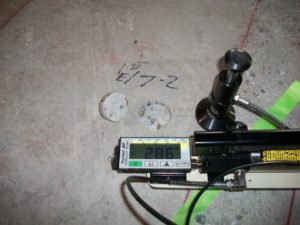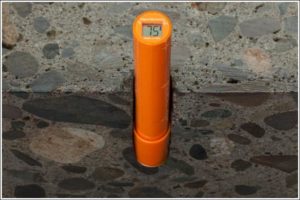Customized Construction Materials Testing
S.W.COLE offers a wide variety of specialty testing to meet the needs of our clients, including many different types of non-destructive forensic tests. If you’re not sure what services you need, don’t worry; our staff will determine which tests are the most appropriate based on our discussions about the project.
In-Service Concrete Foundation and Slab Studies
- In-place Compressive Strength and Reinforcement Location
Non-destructive testing can be applied to both old and new structures. The principal application in new construction is likely for quality control or the resolution of doubts about the quality of materials or construction. The testing of concrete in existing structures is usually related to an assessment of structural integrity or adequacy. In-place concrete compressive strength is determined by obtaining, preparing and testing core samples in accordance with ASTM C 42. The cores are gathered with the use of a diamond thin wall core barrel. Show More...
Concrete constructions also rely on reinforcing steel to provide necessary tensile strength. Sufficient concrete cover above the reinforcing steel is another the key factor in determining the design life of a concrete structure. An instrument for non-destructive rebar detection that quickly and accurately determines the location of the reinforcing bars can help avoid damage while obtaining samples or accessing proper placement.
- Pull-Off Testing

Pull off testing demonstration
Pull-off testing is a non-destructive method for the evaluation of concrete and other rigid surfaces.
The test has a few steps. After the test surface is prepped, a small aluminum disc, known as a dolly, is adhered to the surface with high strength epoxy and is allowed to cure. Then, a uniform amount of pressure is applied to the dolly with a calibrated hand held hydraulic jack, and this pressure is then increased gradually until failure.
Show More...
This test method determines the tensile strength of concrete near to the prepared surface, which can be used as an indicator of the adequacy of surface preparation before applying a repair or an overlay material. When the test is performed on the surface of a repair or an overlay material, it determines the bond strength to the substrate or the tensile strength of either the overlay or substrate, whichever is weaker.
The pull-off strength of a coating is an important performance property that has been used in specifications. This test method serves as a means for uniformly preparing and testing coated surfaces, and evaluating and reporting the results.
- Impact-Echo Testing
Impact-echo (IE) is a quick, relatively inexpensive method for nondestructive testing of concrete and masonry structures. It uses impact-generated stress (sound) waves that travel though the concrete or masonry and are reflected by internal flaws and external surfaces.
IE testing can be used to determine many properties and flaws in concrete without causing any physical damage, including the depth of surface cracks in concrete and the location of grouted cells in concrete masonry units.
- Ultrasonic Pulse Velocity Meter
Ultrasonic pulse velocity testing of concrete uses the pulse velocity method to provide information on the uniformity of concrete, cavities, cracks and defects.
The pulse velocity in a material depends on its density and its elastic properties, which in turn are related to the quality and the compressive strength of the concrete. It is therefore possible to obtain information about the properties of components by sonic investigations.
- Concrete Surface Resistivity Testing
Construction projects such as roads, bridges, dams, piers, parking garages or retaining walls contain concrete mixtures that are often placed in environments with a high salt or chloride exposure. This exposure can potentially develop corrosion of the embedded reinforcing steel, which can potentially compromise the structure.
Show More...
Concrete surface resistivity testing is used to determine potential chloride ion permeability (or penetration) of hardened concrete.
The surface resistivity test performed by S.W.COLE is a non-destructive method of measuring concrete resistivity using a small hand-held electrical device that takes minutes to perform. The test can be performed on cast test cylinders or on in-place structures.
- Concrete Slab Moisture Vapor and Relative Humidity Testing
Relative humidity (RH) testing measures the amount of moisture in a concrete floor. Related to – and often used in conjunction with – the RH level of a slab is the moisture vapor emission rate (MVER), or the rate at which moisture is evaporating from the slab.
Show More...

A relative humidity probe in a cross-section of cement
There are two recognized methods for measuring the moisture condition of a concrete slab. One test, known as a moisture dome test, measures the surface moisture using calcium chloride, and the other, known as an in-situ relative humidity probe test, measures the moisture condition inside the concrete. In order to form a complete picture of the slab’s moisture content, both measurements are often specified.
Moisture condition testing can be very important on a construction project. Published ASTM standards – and most flooring manufacturers – state that in order for concrete to be considered ready for flooring, the RH of the slab (measured by in-situ probes) and the MVER (measured by moisture domes) must meet certain acceptable levels. Flooring that is placed or installed on a concrete slab that has not cured long enough to allow the proper amount of moisture to evaporate may crack, bubble or warp, which can lead to costly repairs, project delays or, in some cases, litigation.
Blast Monitoring and Pre-Construction Services
Because the subsurface conditions in New England often require blasting or hammering for bedrock removal, seismic monitoring services such as pre-blast surveys and vibration monitoring can be helpful for documenting conditions prior to the start of a project. Learn more about our services here.
Other Specialized Testing
- Floor Flatness Testing
This test method provides statistical (and graphical) information concerning floor surface profiles using a dipstick auto-read profiler.
Show More...
This test method covers a quantitative method of measuring floor surface profiles to obtain estimates of the floor’s characteristic FF Flatness and FL Levelness Face Floor Profile Numbers (F-Numbers).
F-number measurements are standardized under ASTM E 1155 “Standard Test Method for Determining FF Floor Flatness and FL Floor Levelness Numbers” and the ACI 302.1R-04 “Guide for Concrete Floor and Slab Construction.”
- Alkali Silica Reaction Testing
An alkali–silica reaction (ASR) occurs over time in concrete between the highly alkaline cement paste and the reactive silica found in many common aggregates. With sufficient moisture, this reaction causes the expansion of the altered aggregate by the formation of a swelling gel made of calcium silicate hydrate.
Show More...
The gel increases in volume with water and exerts an expansive pressure inside the material, causing spalling and loss of strength of the concrete, finally leading to its failure. ASR can cause serious cracking in concrete, resulting in critical structural problems.
ASR testing can be performed by following the guidelines set forth in ASTM C 1260 or ASTM C 1557. Either method is intended to evaluate the potential harmful expansion of an aggregate or combination of an aggregate with pozzolan or slag due to any form of alkali-silica reactivity.

